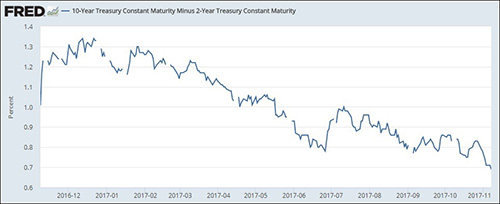By Pam Martens and Russ Martens: November 9, 2017
In November of 2016, there was more than 100 basis points (one percent) difference between the yield on the 2-year and the 10-year U.S. Treasury Note. As of this morning, that difference stood at 68 basis points, a dramatic flattening in the yield curve and harkening to the levels seen during the onset of the financial crisis in 2007.
As of 7:48 a.m. this morning, the spread between the 10-year Treasury Note (yielding 2.33 percent) and 30-year Treasury Bond (yielding 2.81 percent) is even smaller, at a meager 48 basis points or less than half of one percent.
It is a serious commentary on the bizarre financial times in which we live that a fixed income investor would be rewarded with less than half a percent of additional income to add 20 years of risk to the maturity date on his bond.
The Treasury yield curve is the sine qua non to bond investors because it is thought to represent the composite wisdom on the future of the U.S. economy from a vast body of diverse Treasury buyers – from pension funds to insurance companies to mutual funds to mom and pop investors.
A growing economy with related worries about increases in future inflation would typically produce rising yields on longer-term notes and bonds, not declining yields. A dramatic flattening in the yield curve is seen as a red flag for an economic slowdown, sagging inflation and as a potential precursor to the onset of recession. None of that would be consistent with the Federal Reserve continuing to tighten interest rates – which it is expected to do again in December.
The dramatic flattening in the yield curve comes at an inopportune time for the Federal Reserve, which is in the midst of passing the baton from a known factor, Chair Janet Yellen, to a less known factor, newly nominated Fed Chair, Jerome Powell. Unlike his recent predecessors, Powell holds no degree in economics. He has a law degree from Georgetown University Law Center and a B.A. in Politics from Princeton University. Powell has served as a member of the Fed Board of Governors since 2012. From 1997 through 2005, Powell was a partner at the private equity firm, the Carlyle Group. He also has significant Wall Street investment bank experience, having previously worked in executive positions at Dillon Reed and Bankers Trust.
Powell’s Senate confirmation hearing is set for November 28 and it is anticipated that he will take the reins at the Fed in February when Yellen’s term expires.
Traders of shares in the largest Wall Street banks have taken note of the flattening yield curve with cumulative share losses in the range of two to four percent over the past four trading sessions. JPMorgan Chase, which closed at $101.59 on Thursday, November 2, ended the trading day yesterday at $97.64.
Bank stocks, the Treasury market and its yield curve may also be re-pricing the prospect of a lame duck presidency less than 10 months into the first term of Donald Trump. See Four Big Banks Lose $37.60 Billion in Market Cap in Trump Fallout as a guide to what happened on the day it was announced that Deputy Attorney General Rod Rosenstein signed an order naming former FBI Director, Robert Mueller, to become the Special Counsel for an inquiry into the Trump campaign’s involvement with Russia. The first indictments in that matter were unsealed in Federal Court on Monday, October 30.


